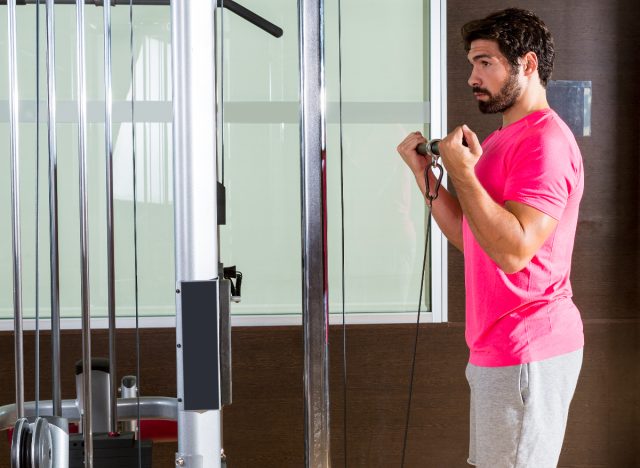10 Common Bicep-Building Mistakes—and What To Do Instead

Building stronger, more muscular biceps is a popular goal for many fitness enthusiasts—and for good reason. Beyond aesthetics, strong arms help you perform daily tasks with ease, boost your athletic performance, and improve posture. However, it's not uncommon to make training errors that set back your muscle-building progress. From only using a partial range of motion to lifting too heavy, these mistakes can prevent you from achieving your desired results. So, we chatted with a fitness professional who calls out 10 common bicep-building mistakes and how to fix them.
10 Common Mistakes When Training and Growing Your Biceps
Stan Kravchenko, celebrity coach and founder of OneFit.com, shares 10 common errors to avoid if you want to effectively train and grow your biceps.
1. Using Momentum
"A very common mistake is using other body parts, like hips, legs, shoulders, or elbows, instead of isolating the biceps," Kravchenko explains. "Proper form requires strict elbow flexion with a full range of motion, focusing on the biceps only."
2. Short Range of Motion

Many gym-goers perform bicep curls using just a partial range of motion, which doesn't provide the complete benefits of the exercise. "Aim for complete elbow extension and flexion to maximize biceps growth," Kravchenko stresses. "Fully extend and flex your arm on each rep. Try standing cable, dumbbell, barbell, or incline bench curls to encourage full range."
3. Going Too Heavy or Too Light
If you think you need to lift heavy to fast-track results, think again. Working with weights that are too light also won't deliver your desired results. It's all about finding the ultimate sweet spot.
"Lifting too heavy can lead to bad form and possibly injuries while lifting too light might not stimulate muscle growth," Kravchenko says. "Find a challenging weight that allows you to push close to failure, with good form, by the last few reps."
Kravchenko recommends working with around eight to 15 reps with one to two reps in reserve. He also says to choose a challenging weight where the last couple of reps are "difficult but manageable."
4. Training in the Same Range

Going through the same range of motion, such as standing bicep curls, limits your muscles' potential for growth. "Incorporate exercises like incline bench curls (for greater stretch) or preacher curls (for shorter range) to challenge the muscle in different ranges," Kravchenko recommends.
5. Sticking to the Same Grip
Always opting for a supinated grip can seriously limit your gains. Kravchenko suggests working with various grips, such as neutral and pronated, to fire up the biceps at different angles "and promote balanced growth." He adds, "Incorporate hammer curls or reverse curls to change the grip and challenge different parts of the biceps."
6. Not Controlling the Pace

Rushing your reps is a major no-no. "Speeding through reps reduces the time under tension, which is crucial for growth and can lead to injury," says Kravchenko. "Aim for a controlled one to two-second lift and a one to two-second lowering phase to have full benefit."
7. Skipping the Negative
Don't forget to show the lowering phase of the movement some love. "The eccentric (lowering) phase of the lift is just as important as the concentric," Kravchenko explains. "Slowing down the lowering phase can lead to better strength and size gains."
8. Not Following a Consistent Program

Consistency is key in any successful fitness routine—bicep-building is no exception. "Constantly changing your workout routine makes it difficult to track progress," Kravchenko points out. "Stick to a set program for a few months to ensure you [make] measurable gains through progressive overload."
9. Overtraining or Undertraining
Training your biceps too much or too little can both have consequences. "Aim for 10 to 15 sets per week spread over two to three sessions," Kravchenko recommends. "Avoid doing too many sets in one session—focus on quality, not quantity."
10. Neglecting Isolation Exercises
Don't sleep on isolation exercises. "Exercises like preacher curls or using incline bench for stability, which stabilize the elbow, are crucial for isolating the biceps," Kravchenko explains. "These exercises give the ability to proper form and prevent momentum from taking over, which leads to more accurate tracking of progress and making results."









